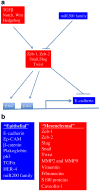Role of epithelial-to-mesenchymal transition (EMT) in drug sensitivity and metastasis in bladder cancer
- PMID: 20012924
- PMCID: PMC5915353
- DOI: 10.1007/s10555-009-9194-7
Role of epithelial-to-mesenchymal transition (EMT) in drug sensitivity and metastasis in bladder cancer
Abstract
Epithelial-to-mesenchymal transition (EMT) is a process that plays essential roles in development and wound healing that is characterized by loss of homotypic adhesion and cell polarity and increased invasion and migration. At the molecular level, EMT is characterized by loss of E-cadherin and increased expression of several transcriptional repressors of E-cadherin expression (Zeb-1, Zeb-2, Twist, Snail, and Slug). Early work established that loss of E-cadherin and increased expression of MMP-9 was associated with a poor clinical outcome in patients with urothelial tumors, suggesting that EMT might also be associated with bladder cancer progression and metastasis. More recently, we have used global gene expression profiling to characterize the molecular heterogeneity in human urothelial cancer cell lines (n = 20) and primary patient tumors, and unsupervised clustering analyses revealed that the cells naturally segregate into two discrete "epithelial" and "mesenchymal" subsets, the latter consisting entirely of muscle-invasive tumors. Importantly, sensitivity to inhibitors of the epidermal growth factor receptor (EGFR) or type-3 fibroblast growth factor receptor (FGFR3) was confined to the "epithelial" subset, and sensitivity to EGFR inhibitors could be reestablished by micro-RNA-mediated molecular reversal of EMT. The results suggest that EMT coordinately regulates drug resistance and muscle invasion/metastasis in urothelial cancer and is a dominant feature of overall cancer biology.
Figures


Similar articles
-
Epithelial-To-Mesenchymal Transition and Its Correlation With Clinicopathologic Features in Patients With Urothelial Carcinoma of the Bladder.Clin Genitourin Cancer. 2017 Apr;15(2):e187-e197. doi: 10.1016/j.clgc.2016.07.021. Epub 2016 Aug 9. Clin Genitourin Cancer. 2017. PMID: 27601277
-
miR-200 expression regulates epithelial-to-mesenchymal transition in bladder cancer cells and reverses resistance to epidermal growth factor receptor therapy.Clin Cancer Res. 2009 Aug 15;15(16):5060-72. doi: 10.1158/1078-0432.CCR-08-2245. Epub 2009 Aug 11. Clin Cancer Res. 2009. PMID: 19671845 Free PMC article.
-
Krüppel-like factor 4 is a novel prognostic predictor for urothelial carcinoma of bladder and it regulates TWIST1-mediated epithelial-mesenchymal transition.Urol Oncol. 2016 Nov;34(11):485.e15-485.e24. doi: 10.1016/j.urolonc.2016.07.002. Epub 2016 Aug 9. Urol Oncol. 2016. PMID: 27519276
-
Epithelial-mesenchymal transition in ovarian cancer progression: a crucial role for the endothelin axis.Cells Tissues Organs. 2007;185(1-3):85-94. doi: 10.1159/000101307. Cells Tissues Organs. 2007. PMID: 17587812 Review.
-
Bypassing cellular EGF receptor dependence through epithelial-to-mesenchymal-like transitions.Clin Exp Metastasis. 2008;25(6):685-93. doi: 10.1007/s10585-007-9121-7. Epub 2008 Jan 31. Clin Exp Metastasis. 2008. PMID: 18236164 Free PMC article. Review.
Cited by
-
LSD1 Promotes Bladder Cancer Progression by Upregulating LEF1 and Enhancing EMT.Front Oncol. 2020 Jul 28;10:1234. doi: 10.3389/fonc.2020.01234. eCollection 2020. Front Oncol. 2020. PMID: 32850370 Free PMC article.
-
IL-6 expression predicts treatment response and outcome in squamous cell carcinoma of the esophagus.Mol Cancer. 2013 Apr 5;12:26. doi: 10.1186/1476-4598-12-26. Mol Cancer. 2013. PMID: 23561329 Free PMC article.
-
Selective Pro-Apoptotic Activity of Novel 3,3'-(Aryl/Alkyl-Methylene)Bis(2-Hydroxynaphthalene-1,4-Dione) Derivatives on Human Cancer Cells via the Induction Reactive Oxygen Species.PLoS One. 2016 Jul 5;11(7):e0158694. doi: 10.1371/journal.pone.0158694. eCollection 2016. PLoS One. 2016. PMID: 27380262 Free PMC article.
-
Immunoexpression of N-cadherin, Twist and Vimentin in Bladder Urothelial Carcinomas.Curr Health Sci J. 2015 Jul-Sep;41(3):219-226. doi: 10.12865/CHSJ.41.03.05. Epub 2015 Jan 29. Curr Health Sci J. 2015. PMID: 30534426 Free PMC article.
-
Molecular characterization of type I IFN-induced cytotoxicity in bladder cancer cells reveals biomarkers of resistance.Mol Ther Oncolytics. 2021 Nov 12;23:547-559. doi: 10.1016/j.omto.2021.11.006. eCollection 2021 Dec 17. Mol Ther Oncolytics. 2021. PMID: 34938855 Free PMC article.
References
-
- Peinado H, Olmeda D, Cano A. Snail, Zeb and bHLH factors in tumour progression: an alliance against the epithelial phenotype? ature Reviews Cancer. 2007;7:415–428. - PubMed
-
- De Donatis A, Comito G, Buricchi F, et al. Proliferation versus migration in platelet-derived growth factor signaling: the key role of endocytosis. Journal of Biological Chemistry. 2008;283:19948–19956. - PubMed
-
- Giese A, Loo MA, Tran N, Haskett D, Coons SW, Berens ME. Dichotomy of astrocytoma migration and proliferation. International Journal of Cancer. 1996;67:275–282. - PubMed
-
- Engel ME, Datta PK, Moses HL. Signal transduction by transforming growth factor-beta: a cooperative paradigm with extensive negative regulation. Journal of Cellular Biochemistry Supplement. 1998;30–31:111–122. - PubMed
-
- Horiguchi K, Shirakihara T, Nakano A, Imamura T, Miyazono K, Saitoh M. Role of Ras signaling in the induction of snail by transforming growth factor-beta. Journal of Biological Chemistry. 2009;284:245–253. - PubMed
Publication types
MeSH terms
Substances
Grants and funding
LinkOut - more resources
Full Text Sources
Other Literature Sources
Medical
Research Materials
Miscellaneous

